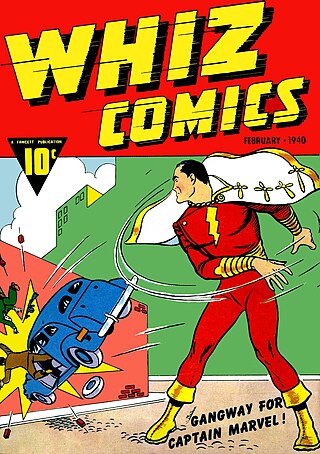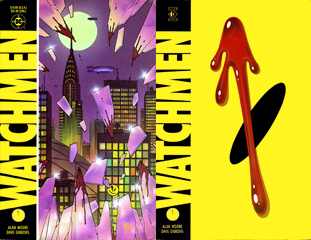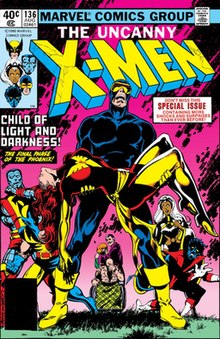
Captain America is a superhero created by Joe Simon and Jack Kirby who appears in American comic books published by Marvel Comics. The character first appeared in Captain America Comics #1, published on December 20, 1940, by Timely Comics, a corporate predecessor to Marvel. Captain America's civilian identity is Steve Rogers, a frail man enhanced to the peak of human physical perfection by an experimental "super-soldier serum" after joining the United States Army to aid the country's efforts in World War II. Equipped with an American flag-inspired costume and a virtually indestructible shield, Captain America and his sidekick Bucky Barnes clashed frequently with the villainous Red Skull and other members of the Axis powers. In the final days of the war, an accident left Captain America frozen in a state of suspended animation until he was revived in modern times. He resumes his exploits as a costumed hero and becomes leader of the superhero team the Avengers, but frequently struggles as a "man out of time" to adjust to the new era.

A superhero or superheroine is a stock character who typically possesses superpowers or abilities beyond those of ordinary people, is frequently costumed concealing their identity, and fits the role of the hero; typically using their powers to help the world become a better place, or dedicating themselves to protecting the public and fighting crime. Superhero fiction is the genre of fiction that is centered on such characters, especially, since the 1930s, in American comic books, as well as in Japanese media.

The Justice League, or Justice League of America (JLA), is a group of superheroes appearing in American comic books published by DC Comics. The team first appeared in The Brave and the Bold #28. The team was conceived by writer Gardner Fox as a revival of the Justice Society of America, a similar team from DC Comics from the 1940s which had been pulled out of print due to a decline in sales.

Captain Marvel, also known as Shazam and the Captain, is a superhero in American comic books originally published by Fawcett Comics and currently published by DC Comics. Artist C. C. Beck and writer Bill Parker created the character in 1939. Captain Marvel first appeared in Whiz Comics #2, published by Fawcett Comics. He is the alter ego of Billy Batson, a boy who, by speaking the magic word "SHAZAM!", is transformed into a costumed adult with the powers of superhuman strength, speed, flight, and other abilities. The character battles an extensive rogues' gallery, most of them working in tandem as the Monster Society of Evil, including primary archenemies Black Adam, Doctor Sivana and Mister Mind. Billy often shares his powers with other children, primarily his sister Mary Batson and their best friend/foster brother Freddy Freeman, who also transform into superheroes and fight crime with Billy as members of the Marvel Family, also known as the Shazam Family.

Ultimate Marvel, later known as Ultimate Comics, was an imprint of comic books published by Marvel Comics, featuring reimagined and modernized versions of the company's superhero characters from the Ultimate Marvel Universe, later known as the Ultimate Universe. Those characters include Spider-Man, the X-Men, the Ultimates, the Fantastic Four, and others. The imprint was launched in 2000 with the publication of the series Ultimate Spider-Man and Ultimate X-Men in 2001, followed by The Ultimates and Ultimate Fantastic Four in 2002 and 2004 respectively providing new origin stories for the characters. The reality of Ultimate Marvel is designated as Earth-1610 as part of the Marvel Comics Multiverse.

Nelson Alexander Ross is an American comic book writer and artist known primarily for his painted interiors, covers, and design work. He first became known with the 1994 miniseries Marvels, on which he collaborated with writer Kurt Busiek for Marvel Comics. He has since done a variety of projects for both Marvel and DC Comics, such as the 1996 miniseries Kingdom Come, which he also cowrote. Since then he has done covers and character designs for Busiek's series Astro City, and various projects for Dynamite Entertainment. His feature film work includes concept and narrative art for Spider-Man (2002) and Spider-Man 2 (2004), and DVD packaging art for the M. Night Shyamalan film Unbreakable (2000). He has done covers for TV Guide, promotional artwork for the Academy Awards, posters and packaging design for video games, and his renditions of superheroes have been merchandised as action figures.
In American comic books and other stories with a long history, first appearance refers to the first issue to feature a fictional character. These issues are often highly valued by collectors due to their rarity and iconic status.

The Modern Age of Comic Books is a period in the history of American superhero comic books which began in the mid-1980s and continues through the present day. During approximately the first 15 years of this period, many comic book characters were redesigned, creators gained prominence in the industry, independent comics flourished, and larger publishing houses became more commercialized.

Miss America is a superhero appearing in American comic books published by Marvel Comics. Created by writer Otto Binder and artist Al Gabriele, the character first appeared in Marvel Mystery Comics #49 in the Golden Age of Comic Books. Madeline Joyce is the first incarnation of Miss America. The character has also been a member of the Invaders, Liberty Legion, and All-Winners Squad at various points in her history.
Bucky is the name used by several different fictional characters appearing in American comic books published by Marvel Comics, usually as a sidekick to Captain America. The original version was created by Joe Simon and Jack Kirby and first appeared in Captain America Comics #1, which was published by Marvel's predecessor, Timely Comics. Following the apparent death of the hero James "Bucky" Barnes, the Bucky nickname and costume have been used by various heroes including: Fred Davis, Jack Monroe, Rick Jones, Lemar Hoskins, and Rikki Barnes. For a time, a child looked after by Jack Monroe was named "Bucky," but she was later adopted and given the name Julia Winters.

Sabra is a character appearing in American comic books published by Marvel Comics. Created by writer Bill Mantlo and artist Sal Buscema, the character first appeared in Incredible Hulk #250 in a cameo, before making a full appearance in Incredible Hulk #256. Sabra is the alter ego of the Israeli superheroine Ruth Bat-Seraph. She is a mutant, and serves as an agent to the Israeli secret service known as the Mossad.

Whiz Comics is an anthology comic book series that was published by former American comic book publishing company, Fawcett Publications between February 1940 until June 1953. It is widely known for being the comic run in which hugely popular superhero character Captain Marvel (Shazam) made his debut.

The All-Winners Squad is a fictional superhero team appearing in American comic books published by Marvel Comics. The company's first such team, it first appeared in All Winners Comics #19, published by Marvel predecessor Timely Comics during the period fans and historians call the Golden Age of Comic Books.

Betsy Ross is a character appearing in American comic books published by Marvel Comics. Created by Joe Simon and Jack Kirby, the character first appeared in Captain America Comics #1. Betsy Ross is Captain America's early love interest and supporting character in American comic books published by Marvel Comics during the 1930-1940s period known to historians and collectors as the Golden Age of Comic Books. She then debuted as the superheroine Golden Girl in Captain America Comics #66.

Carol Susan Jane Danvers is a character appearing in American comic books published by Marvel Comics. Created by writer Roy Thomas and artist Gene Colan, the character first appeared as an officer in the United States Air Force and a colleague of the Kree superhero Mar-Vell in Marvel Super-Heroes #13. Danvers later became the first incarnation of Ms. Marvel in Ms. Marvel #1 after her DNA was fused with Mar-Vell's during an explosion, giving her superhuman powers. Debuting in the Silver Age of comics, the character was featured in a self-titled series in the late 1970s before becoming associated with the superhero teams the Avengers and the X-Men. The character has also been known as Binary, Warbird, and Captain Marvel at various points in her history, and as Vers in the film Captain Marvel.

Superhero fiction is a subgenre of speculative fiction examining the adventures, personalities and ethics of costumed crime fighters known as superheroes, who often possess superhuman powers and battle similarly powered criminals known as supervillains. The genre primarily falls between hard fantasy and soft science fiction in the spectrum of scientific realism. It is most commonly associated with American comic books, though it has expanded into other media through adaptations and original works.

Superhero comics is one of the most common genres of American comic books. The genre rose to prominence in the 1930s and became extremely popular in the 1940s and has remained the dominant form of comic book in North America since the 1960s. Superhero comics feature stories about superheroes and the universes these characters inhabit.

The Destroyer is the name of three fictional superheroes appearing in American comic books published by Marvel Comics. The original incarnation was created by writer Stan Lee and artist Jack Binder and first appeared in Mystic Comics #6, being one of Lee's earliest creations during the Golden Age of Comic Books.

James Buchanan "Bucky" Barnes is a character appearing in American comic books published by Marvel Comics. Originally introduced as a sidekick to Captain America, the character was created by Joe Simon and Jack Kirby and first appeared in Captain America Comics #1. Barnes' original costume and the Bucky nickname has been used by other heroes in the Marvel Universe over the years.

Jack Monroe is a fictional superhero appearing in American comic books published by Marvel Comics. The character was originally introduced as third sidekick under the Bucky identity, initially treated as the original Bucky Barnes before being retconned as a separate character, and later the most well-known incarnation of Nomad.
















